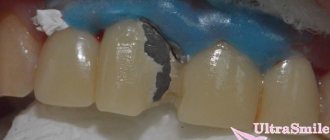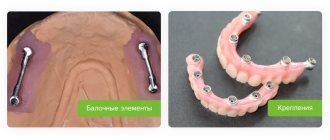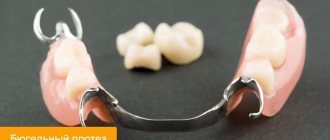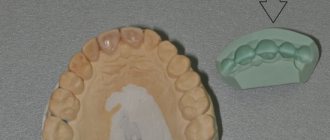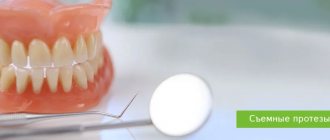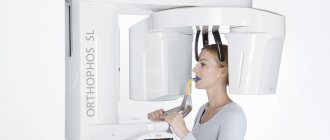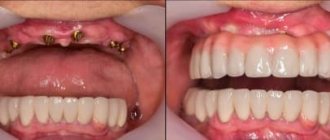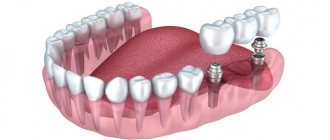Poor fixation of removable dentures is one of the common problems faced by patients. Despite the fact that orthopedists have come up with options for reliable fastening of the structure in the oral cavity, a universal method suitable for everyone without exception has not appeared.
There are several options for the instability of prostheses - immediately after installation and after some time of use. Initial instability is a consequence of improperly selected removable dentures and adjustment of the product to the alveolar process.
Reasons for unsatisfactory fastening
In order for the patient to adapt to the new structures as quickly as possible, experts recommend not removing them even during sleep (despite pain and discomfort in the gum area). As a rule, adaptation to the prosthesis and a tight fit to the crest of the alveoli is achieved 3 weeks after installation.
Sometimes cases occur when a tightly fixed product begins to wobble. The reason of that:
- Unprofessional adjustment of the base - the lower dentition often suffers. This is due to the fact that the jaw is involved in speaking and chewing food. Due to constant mobility, the structure may move from its original location.
- Lack of supporting teeth - if there is one supporting tooth, the fixation weakens over time.
- Anatomical and physiological features of the dentofacial apparatus - incorrect arrangement of teeth, a small amount of bone tissue, etc.
- Incorrectly selected method of fastening - methods such as clasps (wire hooks), screw elements, magnets, attachments (locks), pelots are used for fixation. For each patient, the type of fastening is selected according to individual parameters.
- Looseness of the supporting teeth is observed both before and after fixation of the prosthesis. At the same time, not only molars, but also bridge-like products can become loose. The reason for this is the destruction of the fastening cement.
Linear fracture
In order to repair a denture, a dental technician glues its two parts together with super glue, mixes plaster and makes a plaster model of the denture. After crystallization of the plaster, the prosthesis is removed from the model, again opened into two parts, and a thick layer of plastic is removed from the prosthesis along the fracture line. Using an electric motor and a disc, herringbone cuts are made on the two parts of the prosthesis and they are placed back on the plaster model. Cold polymerization plastic is diluted, after it has matured, it is applied along the fracture line and leveled to the thickness of the prosthesis. The model is placed in cold water for 10-15 minutes to complete polymerization of the plastic. After time, the outer and inner surfaces of the prosthesis are ground using cutters and polished with rubber bands and felt.
Consequences of loose dentures
Failure to see a doctor in a timely manner to correct the problem can cause serious complications that become more noticeable to others:
- Rubbing and injury to periodontal tissues, leading to inflammatory processes and periodontitis;
- discomfort while eating;
- distorted speech;
- change in facial proportions;
- Gastrointestinal diseases associated with poor chewing of food.
In addition, delaying a visit to the dentist can provoke the appearance of purulent abscesses, which subsequently require surgical intervention.
Reviews
Unfortunately, many removable devices, especially complete ones, have insufficient fixation, which causes great discomfort.
Some people deal with this by adapting to the situation - using fixing creams or even changing their lifestyle. Others, without delay, go to the doctor.
If you have had to adjust your dentures due to loss of stability, please share your experience with us. Leave a comment at the bottom of this page.
If you find an error, please select a piece of text and press Ctrl+Enter.
Tags dentures removable dentures
Did you like the article? stay tuned
Previous article
Review of the most popular Korean dental implants
Next article
What is the danger of blood oozing from under the crown of a tooth?
Options for getting out of the current situation
The problem is resolved on an individual basis, taking into account the client’s personal wishes and financial capabilities. Corrective methods include: relining the structure, replacing components, implanting dentures, manufacturing a more advanced structure. Magnetic fixation, adjustment or replacement of fixation mechanisms are also often used.
An important point is that after 3-5 years, even the most expensive products need replacement or adjustment. Timely replacement is the right solution for those who want to have a wonderful smile without huge financial costs.
Recommendations for use
| Click to sign up for a FREE consultation |
The service life of each product directly depends on the source materials, operating conditions and variety. Thus, the service life of an acrylic structure is about 5 years, clasp systems - up to 10 years.
An important aspect is the storage of the prosthesis. It is recommended to store rubber products in water at night, as this prevents their deformation; more modern acrylic and nylon prostheses do not need to be removed at all (if you want to take a break from the prosthesis, the structure can be removed, cleaned and placed in a special case). If you have not worn a removable denture for a long time, it should be treated with an antiseptic before installation.
The main rule for long-term use of a removable denture is regular visits to the doctor. Don't forget to visit the dentist at least once a year.
Solutions to the problem
There are many ways to restore lost stability, differing in the scale of intervention in the structure and tissues of the oral cavity, effectiveness and financial costs.
The choice of a specific method is determined taking into account the clinical situation, the patient’s preferences, and his availability of funds. It could be:
- adjustment or replacement of fixing elements;
- relocation;
- use of fixing creams;
- implantation;
- making a new prosthesis;
- other methods.
Sometimes, although rarely, it is possible to do without adjusting the prosthesis at all, limiting ourselves to teaching the patient how to use it correctly.
There are methods for properly biting and chewing food and controlling your masticatory muscles. By teaching them to the patient, you can solve the problem of fixation without resorting to relining or another method of correction.
Use of fixing agents
The use of fixation creams is considered by dentists as a temporary measure that allows them to use the device with relative comfort until it is repaired or replaced with a new one. A properly manufactured prosthesis should be securely fixed without gluing.
Fixing pastes have different adhesive strengths. Curing of adhesives occurs after their contact with oral fluid. The usual duration of fixing creams is 8-10 hours. That is, you need to apply the cream every day.
The standard technology for its use includes:
- applying the paste in a continuous or intermittent strip to the supporting surface of the base;
- placing the product in place and squeezing it with your teeth for a few seconds (according to the instructions);
- Remove the device in the evening, clean it and the gums from any remaining cream.
The advantages of fixing creams include the ability to temporarily stabilize almost any structure. The main disadvantage is the hassle of use and the need to clean the denture and gums of the cream every day.
Moreover, usually some part of the cream is swallowed, which leaves an unpleasant sensation. In addition, when eating hot food, some creams lose their adhesive strength and require reapplication.
Relocation
Relining is the operation of applying a layer of hardening polymer to the supporting surface of the prosthesis, which exactly repeats the configuration of the alveolar process. This ensures reliable fixation and proper distribution of the chewing load.
One of the objectives pursued by relining is the creation of a circular valve around the supporting surface of the base, ensuring “suction” of the structure to the mucous membrane.
Relocation is carried out in the following sequence.
- Removing a 1 mm thick layer from the supporting surface of the prosthesis, covering the artificial teeth with Vaseline to prevent self-polymerizing plastic from sticking to them.
- Mixing the polymer paste and applying it to the prepared base surface.
- Installing the product in place and closing the teeth. At the same time, the applied plastic copies the shape of the alveolar process, and its excess is squeezed out into the vestibular and oral area.
- After a pause necessary for the initial hardening of the material, the denture is removed from the mouth and placed in a polymerizer to gain final hardness.
- Removal of excess material, grinding.
After this, the product is ready for use. Its supporting surface exactly matches the configuration of the alveolar process.
The technology of clinical relining was described above. A laboratory technique is also used, in which a supporting layer of polymer is applied in the laboratory based on a previously taken impression.
Advantages of relocation:
- obtaining a supporting surface of the base that ideally matches the shape of the alveolar process;
- simplicity and manufacturability of the method.
Flaws:
- the need to get used to the prosthesis again;
- relative high cost (with laboratory relocation, the cost of the operation is comparable to the manufacture of a new product);
- the appearance of the structure may deteriorate due to differences in color and texture of the old and restored parts.
Types of fast-hardening plastics in dentistry and their areas of application.
In this publication, we will consider the designs of removable dentures for the upper jaw.
Here https://www.vash-dentist.ru/protezirovanie/semnyie-p/pochemu-voznikaet-stomatit.html read about the symptoms of denture stomatitis and methods of its treatment.
other methods
In addition to relining and using fixing creams, the following fixation methods are also used.
- Adjusting or replacing the locking mechanism. The simplest operation is tightening the clasps.
In some cases, it is possible to replace them with attachments of various designs, for example, a matrix-matrix system or telescopic crowns.Replacing a mechanism sometimes requires serious adjustments to the product and turning of the supporting tooth to install telescopic bushings.
- Installation of implants of various designs (regular intraosseous, taking on the function of additional supporting teeth, mini-implants, intramucosal structures).
- Magnetic fixation and some others.
The main disadvantage of the above methods is the relatively high cost of operations (with the exception of clasp correction). It makes sense to resort to them only if the product has not lasted long.
If its service life exceeds 3-5 years, it is more advisable to manufacture a new product.
Watch the video to see how the fixation of a denture is improved.
What to do if a bridge or crown becomes uncomfortable
It is worth immediately noting that fixed orthopedic structures - crowns and bridges - cannot be modified. If they do not fit well, then either they were made incorrectly, or the bonding cement has broken down - there is still a chance to “save” the prosthesis, but not always. Another option is that the tooth under the crown has begun to decay. In all these cases, the crown or bridge wobbles and falls off. And the patient is prescribed new prosthetics.
Read on the topic: what to do if the dental bridge begins to loosen - useful recommendations for maintaining the beauty and health of your smile.
Next, we will talk about removable orthopedic structures - how to increase the fit and comfort of wearing.
